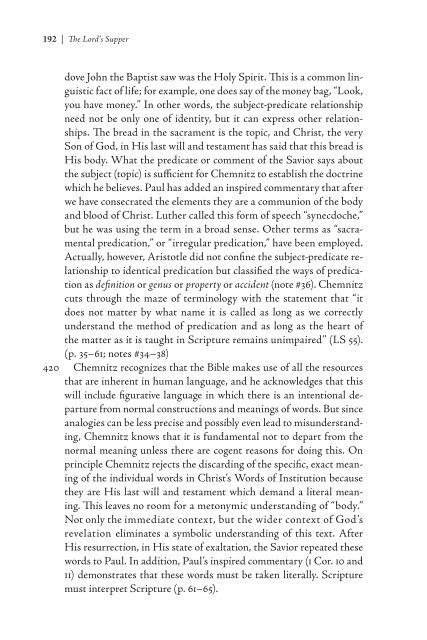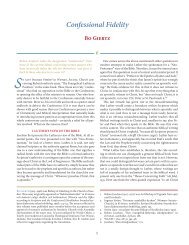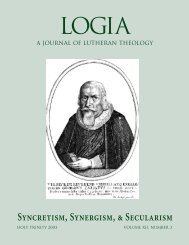The Lord's Supper in the Theology of Martin Chemnitz Bjarne - Logia
The Lord's Supper in the Theology of Martin Chemnitz Bjarne - Logia
The Lord's Supper in the Theology of Martin Chemnitz Bjarne - Logia
You also want an ePaper? Increase the reach of your titles
YUMPU automatically turns print PDFs into web optimized ePapers that Google loves.
| <strong>The</strong> Lord’s <strong>Supper</strong><br />
dove John <strong>the</strong> Baptist saw was <strong>the</strong> Holy Spirit. This is a common l<strong>in</strong>guistic<br />
fact <strong>of</strong> life; for example, one does say <strong>of</strong> <strong>the</strong> money bag, “Look,<br />
you have money.” In o<strong>the</strong>r words, <strong>the</strong> subject-predicate relationship<br />
need not be only one <strong>of</strong> identity, but it can express o<strong>the</strong>r relationships.<br />
<strong>The</strong> bread <strong>in</strong> <strong>the</strong> sacrament is <strong>the</strong> topic, and Christ, <strong>the</strong> very<br />
Son <strong>of</strong> God, <strong>in</strong> His last will and testament has said that this bread is<br />
His body. What <strong>the</strong> predicate or comment <strong>of</strong> <strong>the</strong> Savior says about<br />
<strong>the</strong> subject (topic) is sufficient for <strong>Chemnitz</strong> to establish <strong>the</strong> doctr<strong>in</strong>e<br />
which he believes. Paul has added an <strong>in</strong>spired commentary that after<br />
we have consecrated <strong>the</strong> elements <strong>the</strong>y are a communion <strong>of</strong> <strong>the</strong> body<br />
and blood <strong>of</strong> Christ. Lu<strong>the</strong>r called this form <strong>of</strong> speech “synecdoche,”<br />
but he was us<strong>in</strong>g <strong>the</strong> term <strong>in</strong> a broad sense. O<strong>the</strong>r terms as “sacramental<br />
predication,” or “irregular predication,” have been employed.<br />
Actually, however, Aristotle did not conf<strong>in</strong>e <strong>the</strong> subject-predicate relationship<br />
to identical predication but classified <strong>the</strong> ways <strong>of</strong> predication<br />
as def<strong>in</strong>ition or genus or property or accident (note #36). <strong>Chemnitz</strong><br />
cuts through <strong>the</strong> maze <strong>of</strong> term<strong>in</strong>ology with <strong>the</strong> statement that “it<br />
does not matter by what name it is called as long as we correctly<br />
understand <strong>the</strong> method <strong>of</strong> predication and as long as <strong>the</strong> heart <strong>of</strong><br />
<strong>the</strong> matter as it is taught <strong>in</strong> Scripture rema<strong>in</strong>s unimpaired” (LS 55).<br />
(p. 35–61; notes #34–38)<br />
420 <strong>Chemnitz</strong> recognizes that <strong>the</strong> Bible makes use <strong>of</strong> all <strong>the</strong> resources<br />
that are <strong>in</strong>herent <strong>in</strong> human language, and he acknowledges that this<br />
will <strong>in</strong>clude figurative language <strong>in</strong> which <strong>the</strong>re is an <strong>in</strong>tentional departure<br />
from normal constructions and mean<strong>in</strong>gs <strong>of</strong> words. But s<strong>in</strong>ce<br />
analogies can be less precise and possibly even lead to misunderstand<strong>in</strong>g,<br />
<strong>Chemnitz</strong> knows that it is fundamental not to depart from <strong>the</strong><br />
normal mean<strong>in</strong>g unless <strong>the</strong>re are cogent reasons for do<strong>in</strong>g this. On<br />
pr<strong>in</strong>ciple <strong>Chemnitz</strong> rejects <strong>the</strong> discard<strong>in</strong>g <strong>of</strong> <strong>the</strong> specific, exact mean<strong>in</strong>g<br />
<strong>of</strong> <strong>the</strong> <strong>in</strong>dividual words <strong>in</strong> Christ’s Words <strong>of</strong> Institution because<br />
<strong>the</strong>y are His last will and testament which demand a literal mean<strong>in</strong>g.<br />
This leaves no room for a metonymic understand<strong>in</strong>g <strong>of</strong> “body.”<br />
Not only <strong>the</strong> immediate context, but <strong>the</strong> wider context <strong>of</strong> God’s<br />
revelation elim<strong>in</strong>ates a symbolic understand<strong>in</strong>g <strong>of</strong> this text. After<br />
His resurrection, <strong>in</strong> His state <strong>of</strong> exaltation, <strong>the</strong> Savior repeated <strong>the</strong>se<br />
words to Paul. In addition, Paul’s <strong>in</strong>spired commentary (1 Cor. 10 and<br />
11) demonstrates that <strong>the</strong>se words must be taken literally. Scripture<br />
must <strong>in</strong>terpret Scripture (p. 61–65).




